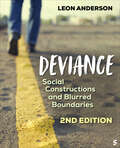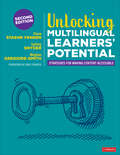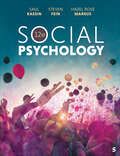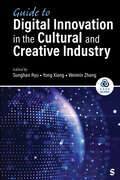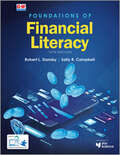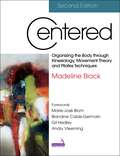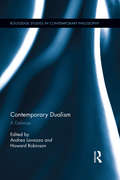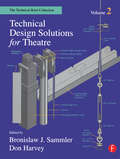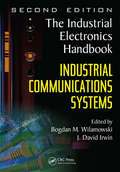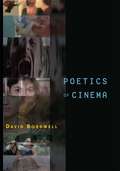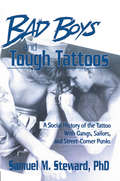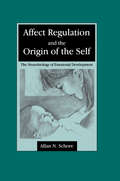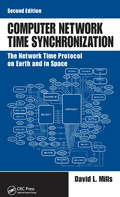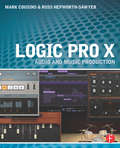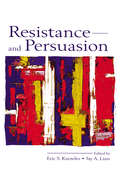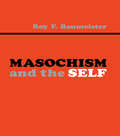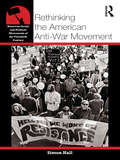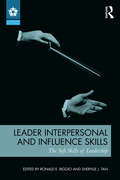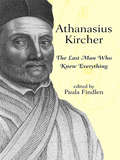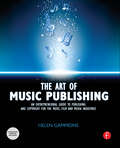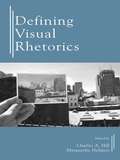- Table View
- List View
Deviance: Social Constructions and Blurred Boundaries
by Leon AndersonDeviance: Social Constructions and Blurred Boundaries is designed for courses on social deviance that take a strong sociological perspective. The book draws on up-to-date scholarship across a wide spectrum of deviance categories, providing a symbolic interactionist analysis of the deviance process. The book addresses positivistic theories of deviant behavior within a description of the deviance process that encompasses the work of deviance claims-makers, rule-breakers, and social control agents. Students are introduced to the sociology of deviance and learn to analyze several kinds of criminal deviance that involve unwilling victims-such as murder, rape, street-level property crime, and white-collar crime. Students also learn to examine several categories of "lifestyle" and "status" deviance and develop skills for critical analysis of criminal justice and social policies. Overall, students gain an understanding of the sociology of deviance through cross-cultural comparisons, historical overview of deviance in the U.S., and up-close analysis of the lived experience of those who are labeled deviant as well as responses to them in the U.S. today
Unlocking Multilingual Learners’ Potential: Strategies for Making Content Accessible
by Diane Staehr Fenner Sydney Cail Snyder Meghan Gregoire-SmithBring classroom content to life for multilingual learners In this eagerly anticipated revision of their bestselling book, authors Diane Staehr Fenner, Sydney Snyder, and Meghan Gregoire-Smith share dynamic, research-backed strategies that every educator of multilingual learners (MLs) can add to their repertoire. Including more of what educators loved from the first edition—authentic classroom examples, a wide variety of research-based instructional strategies, and practical tools to implement across grade levels and content areas—this is the ultimate practical guide to unlocking the potential of MLs in K-12 classrooms. With fresh graphics and eye-catching colors, this thoroughly revised edition also includes: Considerations for newcomers and students with interrupted or no formal education (SLIFE) An added chapter on building scaffolded instruction and peer learning opportunities into MLs’ academic reading and writing activities Additional opportunities for reflection and application A new unit planning template aligned with research-based instructional practices, including a completed example unit Situated within five core beliefs that frame the must-haves for MLs’ equitable and excellent education, Unlocking Multilingual Learners′ Potential is a guide to research-based practices and a toolbox of strategies every educator can implement to make content accessible and increase language proficiency among MLs.
Social Psychology
by Saul Kassin Steven Fein Hazel Rose MarkusNow published by Sage The new Twelfth Edition of Social Psychology by Saul Kassin, Steven Fein, and Hazel Rose Markus captures the excitement of this dynamic and responsive field in our ever-changing world. The authors highlight the most exciting and important foundational and contemporary research, while every chapter also uniquely investigates the influences of culture and social class. In this enthusiastic introduction to social psychology, students delve into their own passion drivers, from favorite sports teams to social media to their own political perspectives, dispelling misconceptions and understanding the scientific foundations that explain our daily interactions and social behaviors. This textbook shows students how social psychology— its theories, research methods, and basic findings—has never been more relevant or more important. This title is accompanied by a complete teaching and learning package. Contact your Sage representative to request a demo. Learning Platform / Courseware Sage Vantage is an intuitive learning platform that integrates quality Sage textbook content with assignable multimedia activities and auto-graded assessments to drive student engagement and ensure accountability. Unparalleled in its ease of use and built for dynamic teaching and learning, Vantage offers customizable LMS integration and best-in-class support. It’s a learning platform you, and your students, will actually love. Learn more. Assignable Video with Assessment Assignable video (available in Sage Vantage) is tied to learning objectives and curated exclusively for this text to bring concepts to life. Watch a sample video now. LMS Cartridge: Import this title’s instructor resources into your school’s learning management system (LMS) and save time. Don’t use an LMS? You can still access all of the same online resources for this title via the password-protected Instructor Resource Site. Learn more.
Guide to Digital Innovation in the Cultural and Creative Industry (SAGE Works)
by Sunghan Ryu Yong Xiang Weimin ZhangThe digital age has brought significant changes to the cultural and creative industries, making it challenging to keep up with the latest trends. The Guide to Digital Innovation in the Cultural and Creative Industry is an informative resource that can help you navigate the revolution. It not only provides a comprehensive understanding of how digital transformation affects existing industries but also outlines emerging business opportunities. Whether you′re an experienced professional or a beginner, this book is an essential resource that will equip you with the knowledge and tools you need to succeed in the rapidly evolving landscape of the cultural and creative industries. Dive into: Democratizing creation: Discover how digital tools break down barriers and empower creators of all levels. From platforms to possibilities: Explore online video streaming, ebook publishing, virtual museums, and more, witnessing the rise of innovative business models. Cutting-edge tech, boundless potential: Delve into AI, blockchain, VR/AR, and other emerging technologies, understanding how they reshape content production, distribution, and consumption. Case studies that examine real-world scenarios, from the digital subscriptions of the New York Times to music consumption in the Spotify era.
Guide to Digital Innovation in the Cultural and Creative Industry (SAGE Works)
by Sunghan Ryu Yong Xiang Weimin ZhangThe digital age has brought significant changes to the cultural and creative industries, making it challenging to keep up with the latest trends. The Guide to Digital Innovation in the Cultural and Creative Industry is an informative resource that can help you navigate the revolution. It not only provides a comprehensive understanding of how digital transformation affects existing industries but also outlines emerging business opportunities. Whether you′re an experienced professional or a beginner, this book is an essential resource that will equip you with the knowledge and tools you need to succeed in the rapidly evolving landscape of the cultural and creative industries. Dive into: Democratizing creation: Discover how digital tools break down barriers and empower creators of all levels. From platforms to possibilities: Explore online video streaming, ebook publishing, virtual museums, and more, witnessing the rise of innovative business models. Cutting-edge tech, boundless potential: Delve into AI, blockchain, VR/AR, and other emerging technologies, understanding how they reshape content production, distribution, and consumption. Case studies that examine real-world scenarios, from the digital subscriptions of the New York Times to music consumption in the Spotify era.
Foundations of Financial Literacy
by Robert L. Dansby Sally R. CampbellFoundations of Financial Literacy provides a comprehensive framework for high school students learning about personal financial responsibility, enabling them to make wise financial decisions, lead productive lives, and achieve financial security. This text includes cross-curricular and portfolio activities throughout, a robust overview of economic principles, and easy-to-understand information for successfully managing milestones such as financing your first car, preparing for college and career, and retirement and estate planning. The 11th edition has been updated to reflect recent changes in tax laws and procedures, and includes updated coverage of current financial practices, such as FICO scores and VantageScore 4.0, trade agreements, and understanding FAFSA for education and personal financial planning.
Troublemaker (Wondergirls #3)
by Jillian BrooksLife was great, until Dad started dating Penny. She is so wrong for him—she's even scared of dogs! But my friend Amanda thinks Penny is the greatest. If I complain about Penny, Amanda gets upset. Then Traci gets mad at me, and Arielle gets mad at her.... I hate it when we fight. We've got to do something before our friendship is totally ruined. RL 4 Ages 8-12 Look for the other books in the wondergirls series about the friendship of four girls at home and at middle school including: #1 The New Girl, #2 Team Player, #4 "And The Winner Is...", #5 Perfect Harmony, #6 The Makeover, and #7 Birthday Blues, with the last book, #8 Growing Pains, on the way.
Centered, Second Edition: Organizing the Body through Kinesiology, Movement Theory and Pilates Techniques
by Madeline BlackThe second edition of Centered offers movement practitioners an interdisciplinary approach to physical training that combines the newest advances in science, adaptative biotensegrity principles, and the synthesis of Pilates, yoga, Gyrotonic® and fitness disciplines integral to the Madeline Black Method™. It clearly explains the complex system of human movement patterns based on gait, weaving together movement science, embodiment practices, movement re-education, and manual skills techniques. The text is generously illustrated with 476 color photos and 25 new color illustrations that together provide movement practitioners with the knowledge and practical exercises to advance their work through the most effective structural and functional movement practices for their clients.Centered 2e is also applicable for the client who wishes to experience their body and develop self-help movement and mindful strategies.Centered 2e provides:easy to follow practical how to' exercises and advanced techniques46 video links for in-depth study and practice of the techniques in actioncorrective movement sequences both with and without Pilates apparatusan understanding of movement patterning from clear descriptions and examplespractice assessment techniques to easily observe movement strategieshow to discover and address the assessment findings and change strategiesembodiment opportunities to explore the methodologyaccessible home program sequences for your clientsways to practice session sequences after each sectionCentered 2e is the manual for any teacher of movement (Pilates, yoga, dance, martial arts, Gyrotonic®), physical trainers, physical therapists, movement practitioners and bodyworkers. Chiropractors, osteopaths, and orthopedic doctors will also gain insights from this book.
Contemporary Dualism: A Defense (Routledge Studies in Contemporary Philosophy)
by Andrea Lavazza Howard RobinsonOntological materialism, in its various forms, has become the orthodox view in contemporary philosophy of mind. This book provides a variety of defenses of mind-body dualism, and shows (explicitly or implicitly) that a thoroughgoing ontological materialism cannot be sustained. The contributions are intended to show that, at the very least, ontological dualism (as contrasted with a dualism that is merely linguistic or epistemic) constitutes a philosophically respectable alternative to the monistic views that currently dominate thought about the mind-body (or, perhaps more appropriately, person-body) relation.
Technical Design Solutions for Theatre: The Technical Brief Collection Volume 2
by Bronislaw J. SammlerThe Technical Brief is a collection of single-focus articles on technical production solutions, published three times a year by the prestigious Yale School of Drama. The primary objective of the publication is to share creative solutions to technical problems so that fellow theatre technicians can avoid having to reinvent the wheel with each new challenge. The range of topics includes scenery, props, painting, electrics, sound and costumes. The articles each describe an approach, device, or technique that has been tested on stage or in a shop by students and professionals. Some articles included are: Building Authentic Elizabethan Ruffs; Simple and Inexpensive Stained Glass; A Quick-Load Floor Pulley Design; A Simple Approach to Stretching Drops; Flexi-Pitch Escape Stairs; Spot-Welding Scrim with Sobo; Handrail Armatures for a Grand Staircase; The Triscuit-Studwall Deck System; A Frameless Turntable; Stand on Stage: Minimum Weight, Maximum Effect; A Self-Paging Cable Tray; Roller Chain Turntable Drives; A Bench-Built XLR Cable Tester
Industrial Communication Systems
by Bogdan M. Wilamowski and J. david IrwinThe Industrial Electronics Handbook, Second Edition, Industrial Communications Systems combines traditional and newer, more specialized knowledge that helps industrial electronics engineers develop practical solutions for the design and implementation of high-power applications. Embracing the broad technological scope of the field, this collection explores fundamental areas, including analog and digital circuits, electronics, electromagnetic machines, signal processing, and industrial control and communications systems. It also facilitates the use of intelligent systems—such as neural networks, fuzzy systems, and evolutionary methods—in terms of a hierarchical structure that makes factory control and supervision more efficient by addressing the needs of all production components. Enhancing its value, this fully updated collection presents research and global trends as published in the IEEE Transactions on Industrial Electronics Journal, one of the largest and most respected publications in the field. Modern communication systems in factories use many different—and increasingly sophisticated—systems to send and receive information. Industrial Communication Systems spans the full gamut of concepts that engineers require to maintain a well-designed, reliable communications system that can ensure successful operation of any production process. Delving into the subject, this volume covers: Technical principles Application-specific areas Technologies Internet programming Outlook, including trends and expected challenges Other volumes in the set: Fundamentals of Industrial Electronics Power Electronics and Motor Drives Control and Mechatronics Intelligent Systems
Poetics of Cinema
by David BordwellBringing together twenty-five years of work on what he has called the "historical poetics of cinema," David Bordwell presents an extended analysis of a key question for film studies: how are films made, in particular historical contexts, in order to achieve certain effects? For Bordwell, films are made things, existing within historical contexts, and aim to create determinate effects. Beginning with this central thesis, Bordwell works out a full understanding of how films channel and recast cultural influences for their cinematic purposes. With more than five hundred film stills, Poetics of Cinema is a must-have for any student of cinema.
Guidelines for Process Hazards Analysis (PHA, HAZOP), Hazards Identification, and Risk Analysis
by Nigel HyattThis unique manual is a comprehensive, easy-to-read overview of hazards analysis as it applies to the process and allied industries. The book begins by building a background in the technical definition of risk, past industrial incidents and their impacts, ensuing legislation, and the language and terms of the risk field. It addresses the different types of structured analytical techniques for conducting Process Hazards Analyses (PHA), provides a "What If" checklist, and shows how to organize and set up PHA sessions. Other topics include layout and siting considerations, Failure Modes and Effect Analysis (FMEA), human factors, loss of containment, and PHA team leadership issues.
Bad Boys and Tough Tattoos: A Social History of the Tattoo With Gangs, Sailors, and Street-Corner Punks 1950-1965
by Samuel M. Steward, PhDExplore the dark subculture of 1950s tattoos!In the early 1950s, when tattoos were the indelible mark of a lowlife, an erudite professor of English--a friend of Gertrude Stein, Thomas Mann, Andre Gide, and Thornton Wilder--abandoned his job to become a tattoo artist (and incidentally a researcher for Alfred Kinsey). Bad Boys and Tough Tattoos tells the story of his years working in a squalid arcade on Chicago’s tough State Street. During that time he left his mark on a hundred thousand people, from youthful sailors who flaunted their tattoos as a rite of manhood to executives who had to hide their passion for well-ornamented flesh. Bad Boys and Tough Tattoos is anything but politically correct. The gritty, film-noir details of Skid Row life are rendered with unflinching honesty and furtive tenderness. His lascivious relish for the young sailors swaggering or staggering in for a new tattoo does not blind him to the sordidness of the world they inhabited. From studly nineteen-year-olds who traded blow jobs for tattoos to hard-bitten dykes who scared the sailors out of the shop, the clientele was seedy at best: sailors, con men, drunks, hustlers, and Hells Angels. These days, when tattoo art is sported by millionaires and the middle class as well as by gang members and punk rockers, the sheer squalor of Bad Boys and Tough Tattoos is a revelation. However much tattoo culture has changed, the advice and information is still sound: how to select a good tattoo artist what to expect during a tattooing session how to ensure the artist uses sterile needles and other safety precautions how to care for a new tattoo why people get tattoos--25 sexual motivations for body artMore than a history of the art or a roster of famous--and infamous--tattoo customers and artists, Bad Boys and Tough Tattoos is a raunchy, provocative look at a forgotten subculture.
Affect Regulation and the Origin of the Self: The Neurobiology of Emotional Development
by Allan N. SchoreDuring the past decade a diverse group of disciplines have simultaneously intensified their attention upon the scientific study of emotion. This proliferation of research on affective phenomena has been paralleled by an acceleration of investigations of early human structural and functional development. Developmental neuroscience is now delving into the ontogeny of brain systems that evolve to support the psychobiological underpinnings of socioemotional functioning. Studies of the infant brain demonstrate that its maturation is influenced by the environment and is experience-dependent. Developmental psychological research emphasizes that the infant's expanding socioaffective functions are critically influenced by the affect-transacting experiences it has with the primary caregiver. Concurrent developmental psychoanalytic research suggests that the mother's affect regulatory functions permanently shape the emerging self's capacity for self-organization. Studies of incipient relational processes and their effects on developing structure are thus an excellent paradigm for the deeper apprehension of the organization and dynamics of affective phenomena. This book brings together and presents the latest findings of socioemotional studies emerging from the developmental branches of various disciplines. It supplies psychological researchers and clinicians with relevant, up-to-date developmental neurobiological findings and insights, and exposes neuroscientists to recent developmental psychological and psychoanalytic studies of infants. The methodology of this theoretical research involves the integration of information that is being generated by the different fields that are studying the problem of socioaffective development--neurobiology, behavioral neurology, behavioral biology, sociobiology, social psychology, developmental psychology, developmental psychoanalysis, and infant psychiatry. A special emphasis is placed upon the application and incorporation of current developmental data from neurochemistry, neuroanatomy, neuropsychology, and neuroendocrinology into the main body of developmental theory. More than just a review of several literatures, the studies cited in this work are used as a multidisciplinary source pool of experimental data, theoretical concepts, and clinical observations that form the base and scaffolding of an overarching heuristic model of socioemotional development that is grounded in contemporary neuroscience. This psychoneurobiological model is then used to generate a number of heuristic hypotheses regarding the proximal causes of a wide array of affect-related phenomena--from the motive force that drives human attachment to the proximal causes of psychiatric disturbances and psychosomatic disorders, and indeed to the origin of the self.
Computer Network Time Synchronization: The Network Time Protocol on Earth and in Space, Second Edition
by David L. MillsCarefully coordinated, reliable, and accurate time synchronization is vital to a wide spectrum of fields—from air and ground traffic control, to buying and selling goods and services, to TV network programming. Ill-gotten time could even lead to the unimaginable and cause DNS caches to expire, leaving the entire Internet to implode on the root servers.Written by the original developer of the Network Time Protocol (NTP), Computer Network Time Synchronization: The Network Time Protocol on Earth and in Space, Second Edition addresses the technological infrastructure of time dissemination, distribution, and synchronization—specifically the architecture, protocols, and algorithms of the NTP. This system has been active in one form or another for almost three decades on the Internet and numerous private networks on the nether side of firewalls. Just about everything today that can be connected to a network wire has support for NTP.This book: Describes the principal components of an NTP client and how it works with redundant servers and diverse network paths Provides an in-depth description of cryptographic and other critical algorithms Presents an overview of the engineering principles guiding network configuration Evaluating historic events that have taken place since computer network timekeeping started almost three decades ago, the author details a number of systems and drivers for current radio, satellites, and telephone modem dissemination and explains how we reckon the time, according to the stars and atoms. The original 16 chapters of the first edition have been rewritten, updated, and enhanced with new material. Four new chapters cover new algorithms and previously uncovered concepts, including timekeeping in space missions.Praise for the first edition:"… For those that need an exhaustive tome on all of the minutiae related to NTP and synchronization, this is the source. … definitive … this book should be considered the last word on the topic."—Ben Rothke on Slashdot.org"… the bible of the subject… contains enough information to take you just as far as you want to go….Dr. Mills is the original developer of NTP."—Books On-Line
Peace in World History (Themes in World History)
by Peter StearnsIn Peace in World History, Peter N. Stearns examines the ideas of peace that have existed throughout history, and how societies have sought to put them into practice. Beginning with the status of peace in early hunter-gatherer and agricultural societies, and continuing through the present day, the narrative gives students a clear view of the ways people across the world have understood and striven to achieve peace throughout history. Topics covered include: Comparison of the ‘pax Romana’ and ‘pax Sinica’ of Rome and China Concepts of peace in Buddhism, Christianity, and Islam, and their historical impact The place of peace in the periods of expanding empires The emergence, starting in the 19th century, of formal schemes to promote peace amid increasingly destructive technologies for warfare Moving away from the view of history as a series of military conflicts, Peace in World History offers a new way of looking at world history by focusing on peace. Showing how concepts of peace have evolved over time even as they have been challenged by war and conflict, this lively and engaging narrative enables students to consider peace as a human possibility.
Logic Pro X: Audio and Music Production
by Mark Cousins Russ Hepworth-SawyerFrom initial demos to mixing and mastering, seasoned authors Mark Cousins and Russ Hepworth-Sawyer show you how to get the most from Logic Pro X. By exploring the essential workflow and the creative possibilities offered by Logic’s virtual instruments and effects, Logic Pro X: Audio and Music Production leads you through the music creation and production process, giving you all the tips and tricks used by the pros to create release-quality recordings.Using full color screenshots throughout, alongside related boxouts that expand on the key concepts, Logic Pro X: Audio and Music Production is an informative and easy-to-read guide to using Logic Pro X.Key features include:Production FAQs – Instructional Walkthroughs and Knowledgebases present information clearly and answer common production–specific problems.Methods – Professional techniques for recording and editing in Logic Pro X – whether you’re dealing with real musicians or cutting-edge virtual instruments.Workflow – Use Logic Pro X’s tools and functions in an optimal way.Website – Access audio examples, samples (Apple Loops), Logic projects, sampler instruments, and instrument patches at www.focalpress.com/cw/cousinsLogic Pro X: Audio and Music Production covers more than just the software; it will help you make the most out of every recording session and will illuminate and inspire your creative and sonic endeavors!
Resistance and Persuasion
by Eric S. Knowles Jay A. LinnResistance and Persuasion is the first book to analyze the nature of resistance and demonstrate how it can be reduced, overcome, or used to promote persuasion. By examining resistance, and providing strategies for overcoming it, this new book generates insight into new facets of influence and persuasion. With contributions from the leaders in the field, this book presents original ideas and research that demonstrate how understanding resistance can improve persuasion, compliance, and social influence. Many of the authors present their research for the first time. Four faces of resistance are identified: reactance, distrust, scrutiny, and inertia. The concluding chapter summarizes the book's theoretical contributions and establishes a resistance-based research agenda for persuasion and attitude change. This new book helps to establish resistance as a legitimate sub-field of persuasion that is equal in force to influence. Resistance and Persuasion offers many new revelations about persuasion: *Acknowledging resistance helps to reduce it.*Raising reactance makes a strong message more persuasive.*Putting arguments into a narrative increases their influence. *Identifying illegitimate sources of information strengthens the influence of legitimate sources.*Looking ahead reduces resistance to persuasive attempts. This volume will appeal to researchers and students from a variety of disciplines including social, cognitive, and health psychology, communication, marketing, political science, journalism, and education.
Masochism and the Self
by Roy F. BaumeisterThis volume provides an integrative theory firmly grounded in current psychology of the self, and offers a fresh, compelling account of one of psychology's most enigmatic behavior patterns. Professor Baumeister provides comprehensive coverage of historical and cross-cultural theories and empirical data on masochism and presents recent, original data drawn from a large data set of anonymous masochistic scripts of fantasies and favorite experiences. Drawn from the latest social psychological research and theories, Professor Baumeister returns the emphasis to the original and proto-typical form of masochism -- sexual masochism - - and explains these phenomena as a means of releasing the individual from the burden of self-awareness. It is the first volume to present a psychological theory compatible with the mounting evidence that most masochists are not mentally ill nor does masochism derives from sadism. Instead, Professor Baumeister finds that masochism emerges as an escapist response to the problematic nature of selfhood and he attempts to foster an understanding of sexual masochism that emphasizes both "escape from self" and "construction of meaning" hypotheses. The book is directed at all those interested in the self and identity in paradoxical behavior patterns and in the construction of meaning, presenting specific clinical recommendations.
Rethinking the American Anti-War Movement (American Social and Political Movements of the 20th Century)
by Simon HallBetween 1965 and 1973, hundreds of thousands of ordinary Americans participated in one of the most remarkable and significant people's movements in American history. Through marches, rallies, draft resistance, teach-ins, civil disobedience, and non-violent demonstrations at both the national and local levels, Americans vehemently protested the country's involvement in the Vietnam War. Rethinking the American Anti-War Movement provides a short, accessible overview of this important social and political movement, highlighting key events and key figures, the movement's strengths and weaknesses, how it intersected with other social and political movements of the time, and its lasting effect on the country. The book is perfect for anyone wanting to obtain an introduction to the Anti-War movement of the twentieth century.
Leader Interpersonal and Influence Skills: The Soft Skills of Leadership (ISSN)
by Ronald E. RiggioThis edited volume explores different models, conceptualizations, and measures of leader interpersonal and influence "soft skills" that are so necessary for effective leadership. These include the communication skills, persuasion skills, political savvy, and emotional abilities used by leaders to inspire, motivate, and move followers toward the accomplishment of goals. The book emanates from the two-day-long 21st Kravis-de Roulet leadership conference, which brought together top scholars working in this area. The intent of the conference and this edited volume is to increase understanding of the interpersonal and influence skills, or "soft skills," of the leader, to highlight state-of-the-art research on the topic, and to provide clear, research-based guidelines for the development of leader skills.Chapter authors are recognized experts in their respective areas, and each section of the book will be introduced by an editor-authored chapter reviewing the specific topic area in brief.
Athanasius Kircher: The Last Man Who Knew Everything
by Paula FindlenFirst published in 2004.Athanasius Kircher (1602-1680) -- German Jesuit, occultist, polymath - was one of most curious figures in the history of science. He dabbled in all the mysteries of his time: the heavenly bodies, sound amplification, museology, botany, Asian languages, the pyramids of Egypt -- almost anything incompletely understood. Kircher coined the term electromagnetism, printed Sanskrit for the first time in a Western book, and built a famous museum collection. His wild, beautifully illustrated books are sometimes visionary, frequently wrong, and yet compelling documents in the history of ideas. They are being rediscovered in our own time. This volume contains new essays on Kircher and his world by leading historians and historians of science, including Stephen Jay Gould, Ingrid Rowland, Anthony Grafton, Daniel Stoltzenberg, Paula Findlen, and Barbara Stafford.-
The Art of Music Publishing: An entrepreneurial guide to publishing and copyright for the music, film, and media industries
by Helen GammonsDo you want to pursue a career and succeed in the lucrative area of music publishing? The Art of Music Publishing provides real inspiration and a tangible hands on perspective to this exciting side of the high-risk, high-reward music business. Prepare yourself for a career in music publishing and understand this complex but profitable part of the music business. Author Gammons walks you through all you need to know * understanding the role of the publisher * copyright * managing rights * income streams * contracts*. Learn how, when and where income is generated in all the current areas of business as well as exploring the new industries offering new income streams and the business models that are developing.The supporting website includes video interviews and podcasts with music business legends.'If there is anything that Helen Gammons doesn't know about music publishing, it's probably not worth knowing! If you want to take it to the next level in music publishing - read this book. I know I'll be referring to it often.'David 'Hawk' WolinskiComposer of "Aint No Body" (Rufus and Chaka Khan) and one of the most covered songs ever."Whether you're already a music publisher or would like to be one, this book will give you a mass of useful information - fresh ideas, up-to-date legal opinions, video interviews with music biz legends, provocative thoughts about where the business is heading, and plenty of good anecdotes."From Simon Napier Bell Manager: The Yardbrids, George Michael and Wham, Marc Bolan. Japan.
Defining Visual Rhetorics
by Charles A. Hill Marguerite HelmersImages play an important role in developing consciousness and the relationship of the self to its surroundings. In this distinctive collection, editors Charles A. Hill and Marguerite Helmers examine the connection between visual images and persuasion, or how images act rhetorically upon viewers. Chapters included here highlight the differences and commonalities among a variety of projects identified as "visual rhetoric," leading to a more precise definition of the term and its role in rhetorical studies. Contributions to this volume consider a wide variety of sites of image production--from architecture to paintings, from film to needlepoint--in order to understand how images and texts work upon readers as symbolic forms of representation. Each chapter discusses, analyzes, and explains the visual aspect of a particular subject, and illustrates the ways in which messages and meaning are communicated visually. The contributions include work from rhetoric scholars in the English and communication disciplines, and represent a variety of methodologies--theoretical, textual analysis, psychological research, and cultural studies, among others. The editors seek to demonstrate that every new turn in the study of rhetorical practices reveals more possibilities for discussion, and that the recent "turn to the visual" has revealed an inexhaustible supply of new questions, problems, and objects for investigation. As a whole, the chapters presented here demonstrate the wide range of scholarship that is possible when a field begins to take seriously the analysis of images as important cultural and rhetorical forces. Defining Visual Rhetorics is appropriate for graduate or advanced undergraduate courses in rhetoric, English, mass communication, cultural studies, technical communication, and visual studies. It will also serve as an insightful resource for researchers, scholars, and educators interested in rhetoric, cultural studies, and communication studies.
